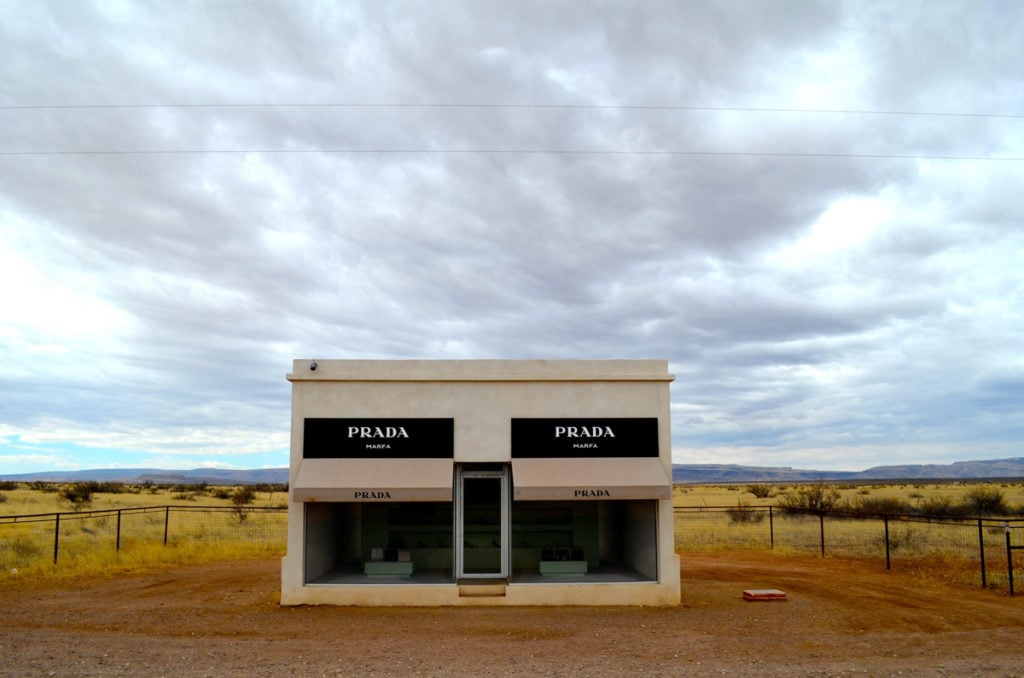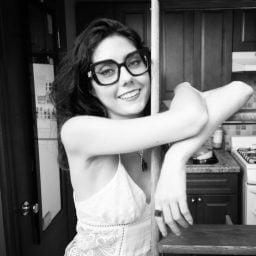Art History
How Two Artists Built a Prada Store in the Middle of the Desert
“It’s almost like being a parent who experienced children growing up and going a direction they never intended,” Elmgreen said of the project.

This October marks the 19th anniversary of Berlin-based art duo Elmgreen & Dragset’s iconic Prada Marfa. To mark the occasion, we are re-sharing our deep dive into the history of the art world favorite installation.
By this point, you’ve probably seen the strange sight of a standalone Prada boutique in the remote desert—whether it was on Beyoncé’s Instagram, or The Simpsons. The ambitious art project is so ubiquitous, yet so misunderstood, that every day, tourists ask, “when does it open?” It doesn’t. That is not the point. Since its construction in 2005, this work of architectural, pop-inspired land art on an abandoned stretch of US-90, 36 miles northwest of Marfa, Texas, has become the definitive case study in how social media has shifted the collective interface with public sculpture.
Michael Elmgreen and Ingar Dragset started parsing the interconnections between art, architecture, and design together in 1995. In 2001, they mounted “Opening Soon/Powerless Structures, Fig. 242” at Tanya Bonakdar Gallery. The show’s main spectacle was a sign reading: “Opening Soon PRADA” on the gallery’s facade. People called Bonakdar with condolences.
That stunt kickstarted Prada Marfa. “This architectural entity of a luxury boutique had suddenly become so present in our culture,” Elmgreen remarked during the duo’s first return to the site in 2019. Prada Marfa would critique consumerism by highlighting its absurdity through isolation.
The duo tried and failed to find a hospitable site in Nevada. Instead, they linked up with New York-based Art Production Fund. Founder Yvonne Force Villareal, who has personal ties to Marfa, connected Elmgreen & Dragset with Ballroom Marfa. The two nonprofits secured funding—and land, lent by the family of the late Walter Alton “Slim” Brown. Elmgreen & Dragset liked Marfa because they felt luxury brands were ripping off the minimalism of Donald Judd, who transformed Marfa into an art destination.
The duo partnered with architects Ronald Rael and Virginia San Fratello to construct Prada Marfa from biodegradable adobe, plaster, and glass. Miuccia Prada let them copy Prada’s logo and interior design, and lent shoes and purses from the house’s Spring/Summer 2005 line.
The night after Prada Marfa unveiled, thieves looted it. Elmgreen & Dragset originally envisioned the building decaying, but they’ve since installed shatterproof windows and alarmed the inventory, even though the handbags have no bottoms, and the shoes all only fit right feet. Local celebrity Boyd Elder looks after the sculpture. Ballroom Marfa maintains it.
Though the boutique is perpetually covered with graffiti, no vandal has measured up to Austin-based artist Joe Magnano, who papered it with TOM’s signage in 2014. The Texas Department of Transportation came after Prada Marfa around then too, deeming it an illegal advertisement after Playboy installed a neon bunny nearby. A steamed Elmgreen told Texas Monthly “This is an embarrassment for that office,” noting the work’s not meant to pimp Prada. Ballroom Marfa saved the day by making Prada Marfa a museum.
But, the work does function somewhat like an ad today. After Instagram launched in 2010, Prada Marfa became one of social media’s elite selfie spots. “It’s almost like being a parent who experienced children growing up and going a direction they never intended,” Elmgreen said in 2019.
As much as Prada Marfa‘s meaning has shifted, however, its appearance remains the same. “You come out here and the landscape, the collection, the way the bags are standing, is exactly the same,” Dragset added on that outing. “Nothing is ever like that.”
What’s the deal with Leonardo’s harpsichord-viola? Why were Impressionists obsessed with the color purple? Art Bites brings you a surprising fact, lesser-known anecdote, or curious event from art history.





